
 Long ago, we built a lightweight Brompton, wrote up the saga in A to B 7, and went on to sell hundreds of extra magazines. We’re still producing photocopies today, which told us something, and maybe Brompton took notice too – there seemed to be interest in reducing the weight of the bike.With hindsight, we did rather well; our fully-equipped 3-speed Brompton tipping the scales at a shade under 10.5kg (23lb), including a front luggage block, mudguards, rear LED and even toe- clips.
Long ago, we built a lightweight Brompton, wrote up the saga in A to B 7, and went on to sell hundreds of extra magazines. We’re still producing photocopies today, which told us something, and maybe Brompton took notice too – there seemed to be interest in reducing the weight of the bike.With hindsight, we did rather well; our fully-equipped 3-speed Brompton tipping the scales at a shade under 10.5kg (23lb), including a front luggage block, mudguards, rear LED and even toe- clips.
 Almost seven years later, Brompton has produced its own lightweight machine. It’s more expensive, and a 2- speed rather than a 3-, but the new S2L-X weighs only 9.7kg (21lb), making it one of the lightest folding bikes in current production, and certainly the lightest Brompton ever produced. If you find the Brompton heavy to carry, this may be the machine for you, but are you willing to pay £965? For Brompton, we doubt whether the opinions of creaky old fogies like us are of any importance, because this chic, hi-tech bike will be aimed at younger people (all the brochure models are under 30), with particular emphasis on young women.
Almost seven years later, Brompton has produced its own lightweight machine. It’s more expensive, and a 2- speed rather than a 3-, but the new S2L-X weighs only 9.7kg (21lb), making it one of the lightest folding bikes in current production, and certainly the lightest Brompton ever produced. If you find the Brompton heavy to carry, this may be the machine for you, but are you willing to pay £965? For Brompton, we doubt whether the opinions of creaky old fogies like us are of any importance, because this chic, hi-tech bike will be aimed at younger people (all the brochure models are under 30), with particular emphasis on young women.
…Brompton needs to attract the sort of people who wouldn’t be seen dead on a Brompton…
Will this lighter, but very much more expensive, bike really appeal to a whole new generation of 20-something professionals? We think Brompton is right to aim for this group, because – if you haven’t noticed – the demographic of cyclists is becoming more and more decrepit. If the folding bike market is to survive and grow, Brompton needs to attract the sort of people who wouldn’t be seen dead on a Brompton. It’s a tall order.
The S2L-X

Narrower, lighter Stelvio tyres
To the untutored eye, the S2L-X is a conventional folding bike.The only unusual bits are straight handlebars, and an odd paint job: Flamingo Pink according to Brompton, but anyone with experience of school dinners in the 1960s and 70s will recognise ‘school blancmange’. Look more closely, and there are other differences: the decal is a designer job, the saddle is sportier, the front forks and rear frame are made of titanium and the bike has narrow Schwalbe Stelvio tyres and a 2-speed derailleur. Look very closely indeed, and you may spot the titanium mudguard stays, new brake levers and alloy headset.There’s lots of technology here, but it only really becomes apparent when you pick the bike up, because it weighs 9.7kg, against 11-12.6kg for the normal bikes.
…other traffic will already be braking, putting the nifty shifter back up front…

Titanium front forks
Jump on, and the feel low and very rigid.The lack of gears doesn’t seem to be a hindrance, because what the bike loses in ratios, it gains in rigidity – the straight bars being much less flexible than the old ‘violin case’ design. By fitting the standard 2-speed derailleur with 12- and 16-tooth sprockets (in place of 13- and 15- tooth), Brompton has given the S2L two well chosen ratios of 56″ and 74″, which one might equate as ‘starting gear’ and ‘riding gear’.With gears like these, you won’t climb any mega-gradients or spin along at 20mph, but the bike copes with hills of up to 10% and – thanks to the lighter rotating bits and single slick gear change – it accelerates well, easily outpacing more cumbersome bikes up to 14mph.Thereafter, the lack of gears begins to tell, but in most city conditions, the other traffic will already be braking for the next traffic lights, putting the nippy shifter back up front. Remember too, that a simple 2-speed derailleur is more efficient than a hub gear.The result is a machine that really demands to be ridden hard and responds well.
…the derailleur slips easily and slickly between the two gears…
We were a little disappointed with the Schwalbe Stelvio tyres when they came out – not because they were slower or heavier than the cutting edge products, but because they were less sturdy without being notably faster or lighter.We questioned whether a weaker tyre was worth fitting for such a small gain. Brompton has clearly decided that it is, claiming a weight saving of 140g (presumably with lighter Schwalbe tubes as well) over the standard Brompton tyres.We didn’t find quite such a big differential, but we’d agree that the Stelvio is the lightest tyre available, albeit by a narrow margin. Brompton makes two cautionary points: avoid using a bottle dynamo, which is liable to shred the sidewalls, and keep the tyre pressures above 85psi or heavier riders will risk ‘pinch punctures’. Otherwise, these tyres are fast, reasonably comfortable (only fatties will need the full 120psi), and light. Aided by the low riding position, 80/100psi in the tyres, and a nice warm spring day, we recorded an excellent 15.4mph roll down speed – one of the fastest runs we’ve seen with 16-inch tyres.We only had time for a few runs, so this figure won’t be very precise, but it’s worth bearing in mind that all three of the folding bikes reviewed in this issue were tested together, so comparisons are certainly valid.

2-speed derailleur. Note the standard Brompton tensioner arm and new free hub
The derailleur slips easily and slickly between the two gears, which are further apart than the standard Brompton 6-speed, but closer – and thus smoother changing – than the Highpath Engineering conversion. Incidentally, anyone intending to take an angle grinder to their new titanium frame in order to fit the Highpath wide ratio cogs will be wasting their time.The 2-speed has a special 9-splined hub which is incompatible with anything else.That’s a shame, because we think some users would prefer a slightly lower first gear, even at the expense of a bigger jump between the two ratios.
Braking feels odd, despite the bike being fitted with familiar dual-pivot callipers.The new Brompton levers obviously impart a different feel, as do the Jagwire cables.We’ve found these super-slick elsewhere, but the cables seemed stretched on this bike, giving a sticky response, particularly at the rear. There’s no fundamental reason why such good cables should bind, so we assume everything will be sorted for production.
Folding, Adjustment & Accessories

Apart from the handlebars, the machine looks fairly conventional
We won’t say much about folding, because the procedure is the same as a traditional Brompton, but once you’ve folded it, 9.7kg is obviously easier to carry than 12kg. Most people find a standard Brompton hard on the arms when crossing a railway bridge or marching between Underground platforms, but this bike is noticeably easier.The same applies when popping up and down stairs – you find yourself doing things with the S2L that you found ways of avoiding with other folding bikes. Folded size is a little larger than previous Bromptons because the comfy new Vitesse saddle is longer.With the saddle right down, we made a cube of 92.3 litres (3.3 cu ft), but the package gets bigger if you put the saddle at the top of its post and/or adjust it backwards, which lengthens the folded package and increases the volume to 105 litres (3.7 cu ft) or even more.To put that in perspective, it’s still 33% smaller than the Mezzo…
Is the bike really going to appeal to the iPod generation? We haven’t seen Tempest Blue or Kew Green (a nice local touch for a West London factory), but Flamingo Pink only seems to hit the spot under the right lighting conditions. In bright natural light, the matt finish and subdued hues can look washed out and lacklustre, but in the right sort of artificial light, the bike really sparkles. More generally, the combination of grey titanium, blue titanium (the seat pillar is treated to reduce scuffing), various shades of silver and shocking pastel pink may or may not appeal.
Once out of the showroom, those with smaller hands should be able to find a comfortable riding position. At long last, Brompton has come round to providing brake levers which are adjustable for reach, but with these handlebars, the levers have to be positioned vertically to prevent a clash with the front wheel when folding, or the front luggage when riding.
 As mentioned elsewhere, luggage does pose a few problems. Brompton uses a standard frame-mounted carrier block which takes three sizes of luggage.These clear the standard handlebars (and the new P-type bars), but tend to restrict the brake cables on the S-type and if over- filled, could foul the handlebars. In practice, the standard Brompton Pannier and folding basket do fit, although it would be wise not to over-fill either. Playing safe, Brompton has introduced a new lower bag (and special low frame) called the S-bag. Produced by Dutch company Radical Design, the S-bag weighs 1.1kg – a little heavier than the Pannier, but lighter than the humungous Touring bag.The S- bag overflows with fashionable zips, pockets, ‘beam me up Scotty’ communicator holsters and all the other accoutrements of modern living. If you don’t hold with such style-things you’re probably the wrong person to be riding the S2L-X anyway. Naturally, the more fashionable youngsters loved the S-bag.
As mentioned elsewhere, luggage does pose a few problems. Brompton uses a standard frame-mounted carrier block which takes three sizes of luggage.These clear the standard handlebars (and the new P-type bars), but tend to restrict the brake cables on the S-type and if over- filled, could foul the handlebars. In practice, the standard Brompton Pannier and folding basket do fit, although it would be wise not to over-fill either. Playing safe, Brompton has introduced a new lower bag (and special low frame) called the S-bag. Produced by Dutch company Radical Design, the S-bag weighs 1.1kg – a little heavier than the Pannier, but lighter than the humungous Touring bag.The S- bag overflows with fashionable zips, pockets, ‘beam me up Scotty’ communicator holsters and all the other accoutrements of modern living. If you don’t hold with such style-things you’re probably the wrong person to be riding the S2L-X anyway. Naturally, the more fashionable youngsters loved the S-bag.
…We’ve seen lighter bikes, but none of them were practical commuters…
Like all new Bromptons, the S2L has a longer frame, so if you’re used to the old model, you’ll find a welcome centimetre or two of extra length here.The Pentaclip fixing also allows the saddle to go a little higher than the old fitting: up to a maximum of 97cm, which should make life easier for those who would consider themselves just too tall for a standard Brompton seat pillar. On the other hand, the handlebars are fixed at a relatively low 92cm (9cm lower than standard).We found that almost everyone who knew and liked the conventional Brompton said they preferred the old handlebars. On the other hand, there may be thousands of others who have rejected the conventional Brompton on the same grounds.They’re the people this bike needs to appeal to.
Conclusion
We’ve seen lighter bikes, but none of them were practical day-to-day commuters, which the S2L certainly is. Sub-10kg bikes don’t generally come with mudguards or luggage carriers, and in most respects this is a conventional Brompton, capable of doing just about anything a conventional Brompton will do. Once you’ve taken a deep breath and paid for it, titanium should last for many years without corroding or failing. Our only concern is with the surface treatment on the seat pillar, which seemed to show signs of mild scuffing after a week or two of fairly intense use.
Competition? The Dahon Helios SL is both lighter, and at £800, cheaper, but it’s hardly equipped for a daily commute, and we’ve heard a few grumbles about spoke problems. Dahon also produces the little Presto Lite, which is claimed to weigh 8.9kg, even in 3-speed form.We can’t verify this because we haven’t tried the bike, but at £570 (currently discounted to £520 or less), it’s a lot cheaper than the S2L.
Competition comes from within the Brompton stable too.We suspect many will opt for the M2L-X, which is £92 cheaper, almost as light, and with the advantage (for some) of more conventional upright handlebars.We’re very, very tempted.
Specification – Brompton S2L-X
Price – £965
Weight – 9.7kg (21lbs) .
Gears – Brompton 2-speed derailleur . Ratios 56″ and 74″ .
Folded Size – W27.2cm L58cm H58.5cm .
Folded Volume – 92.3 litres (3.26 cu ft)
Manufacturer – Brompton Bicycle tel 020 8232 8484
A to B 47 – April 2005
![]()


 Like the Routemaster buses featured last month, new folding bikes seem to arrive in groups of three.This is awkward for those who make a living testing bikes, and bad news for manufacturers too, because if the Mezzo had not been overshadowed by this month’s news from Brentford, it would have been very big news indeed.The Mezzo is a completely new folding bike: all alloy, 16-inch wheels, up-to-the-minute British design, and manufactured in Taiwan to keep the price within three figures. By any standards, that’s big news.
Like the Routemaster buses featured last month, new folding bikes seem to arrive in groups of three.This is awkward for those who make a living testing bikes, and bad news for manufacturers too, because if the Mezzo had not been overshadowed by this month’s news from Brentford, it would have been very big news indeed.The Mezzo is a completely new folding bike: all alloy, 16-inch wheels, up-to-the-minute British design, and manufactured in Taiwan to keep the price within three figures. By any standards, that’s big news. Our test bike is an early production machine, so the spec is bound to change. It will be interesting to see whether our predictions as to where it should change prove correct. First, the frame.The Mezzo has a smart alloy frame, shot-peened to a rough matt finish, and topped with smart modern graphics and gunmetal grey anodising (silver will follow as an option). In terms of both product design and finish, it’s superb, and in a different league to the tasteless, and sometimes rather gormless Chinese things that usually fall out of the box. This is one of the first folding bikes with a proper design pedigree, and it really shows. In terms of looks.The only slightly questionable area is the strangely cranked handlebar stem, of which more below.
Our test bike is an early production machine, so the spec is bound to change. It will be interesting to see whether our predictions as to where it should change prove correct. First, the frame.The Mezzo has a smart alloy frame, shot-peened to a rough matt finish, and topped with smart modern graphics and gunmetal grey anodising (silver will follow as an option). In terms of both product design and finish, it’s superb, and in a different league to the tasteless, and sometimes rather gormless Chinese things that usually fall out of the box. This is one of the first folding bikes with a proper design pedigree, and it really shows. In terms of looks.The only slightly questionable area is the strangely cranked handlebar stem, of which more below.




 Initially, the Mezzo comes with very little in the way of accessories, but we’re pleased to see a proper pair of mudguards.The front one is structural, so it’s an indestructible alloy affair. Otherwise, there’s just a bell and a slightly naff-looking saddle-mounted LED rear light. If ATB is serious about the folding world, the Mezzo needs proper lights, and some sort of luggage system. It has a rear rack, but in the morning commuter maelstrom, the man fiddling with panniers and bungees is the man who misses the train.The bike needs a custom rack-mounted bag and quick-release system, and we’re told there’s one on the way. Proper frame-mounted LED lights are being developed too.
Initially, the Mezzo comes with very little in the way of accessories, but we’re pleased to see a proper pair of mudguards.The front one is structural, so it’s an indestructible alloy affair. Otherwise, there’s just a bell and a slightly naff-looking saddle-mounted LED rear light. If ATB is serious about the folding world, the Mezzo needs proper lights, and some sort of luggage system. It has a rear rack, but in the morning commuter maelstrom, the man fiddling with panniers and bungees is the man who misses the train.The bike needs a custom rack-mounted bag and quick-release system, and we’re told there’s one on the way. Proper frame-mounted LED lights are being developed too.



 Produce any interesting machine and someone will want to customise it. Engineer Steve Parry has been producing custom folding bikes to order for over a decade – concentrating on the Brompton in recent years.
Produce any interesting machine and someone will want to customise it. Engineer Steve Parry has been producing custom folding bikes to order for over a decade – concentrating on the Brompton in recent years.
 Peter Henshaw
Peter Henshaw
 The message from Brompton is one of incremental changes, some small, but others of real importance, or at least, interesting enough to report.Weight is unchanged, as is price, but there have been subtle improvements. To recap briefly, the Brompton has been around since the late 1980s. Although never officially designated as such, early hand-built bike are usually called Mark 1s, the 1991 – 1999 bikes the Mark 2 and more recent machines Mark 3.The post-1999 Mark 3 looked much like its forbears, but was rebuilt almost from scratch, resulting in a lighter, faster and more rugged machine.The only big change since has been from Sturmey Archer 3- or 5-speed hubs to a SRAM 3-speed with the option of a Brompton 2-speed derailleur, giving six gears.
The message from Brompton is one of incremental changes, some small, but others of real importance, or at least, interesting enough to report.Weight is unchanged, as is price, but there have been subtle improvements. To recap briefly, the Brompton has been around since the late 1980s. Although never officially designated as such, early hand-built bike are usually called Mark 1s, the 1991 – 1999 bikes the Mark 2 and more recent machines Mark 3.The post-1999 Mark 3 looked much like its forbears, but was rebuilt almost from scratch, resulting in a lighter, faster and more rugged machine.The only big change since has been from Sturmey Archer 3- or 5-speed hubs to a SRAM 3-speed with the option of a Brompton 2-speed derailleur, giving six gears. The old Sturmey 3-speed shifter was much loved, but has been showing its age (it was designed 70 years ago).The SRAM design is less positive and liable to all sorts of minor niggles, so Brompton designed its own to coincide with the reintroduction of the Sturmey hub, and it will be fitted to all 3-speed bikes.The shifter has a long travel, but to keep it nice and ergonomic there are two levers, one above the other.To change down from 3rd to 2nd, you flick down the lower lever.To change from 2nd to 1st, the upper lever will be in exactly the same place.The lever has to be carefully positioned to work well, but when it does, it’s superb – comfortable and easy to use. Like the rear frame, the new shifter will work with either SRAM or Sturmey hubs, so you can upgrade an older bike if you want.
The old Sturmey 3-speed shifter was much loved, but has been showing its age (it was designed 70 years ago).The SRAM design is less positive and liable to all sorts of minor niggles, so Brompton designed its own to coincide with the reintroduction of the Sturmey hub, and it will be fitted to all 3-speed bikes.The shifter has a long travel, but to keep it nice and ergonomic there are two levers, one above the other.To change down from 3rd to 2nd, you flick down the lower lever.To change from 2nd to 1st, the upper lever will be in exactly the same place.The lever has to be carefully positioned to work well, but when it does, it’s superb – comfortable and easy to use. Like the rear frame, the new shifter will work with either SRAM or Sturmey hubs, so you can upgrade an older bike if you want. A perennial grumble from high mileage owners is rim wear. Brompton isn’t promising to eradicate the problem, but the new ZX1000 rims are better quality, more precisely machined and including a wear indicator slot – when the slot disappears it’s time to change. Anodised (but not on the wearing faces) the rims certainly look smarter, but we’ll have to wait a few months to discover whether they really are tougher in service.
A perennial grumble from high mileage owners is rim wear. Brompton isn’t promising to eradicate the problem, but the new ZX1000 rims are better quality, more precisely machined and including a wear indicator slot – when the slot disappears it’s time to change. Anodised (but not on the wearing faces) the rims certainly look smarter, but we’ll have to wait a few months to discover whether they really are tougher in service.
 Ever get that feeling that the world has become a fast moving and confusing place? Take the world of folding bikes, for example. Not long ago, the Brompton was compact, the Bike Friday was sporty, the Dahon was cheap and cheerful, and almost everything else from the Far East was utter rubbish. In time-honoured fashion, you knew where you were.
Ever get that feeling that the world has become a fast moving and confusing place? Take the world of folding bikes, for example. Not long ago, the Brompton was compact, the Bike Friday was sporty, the Dahon was cheap and cheerful, and almost everything else from the Far East was utter rubbish. In time-honoured fashion, you knew where you were. Oyama will be best known to A to B subscribers for copying the Brompton, launching the rather absurd Space Genie on an unsuspecting public in February 2002.We were less than complimentary to the Space Genie then, and laughed all over again the following year, when this and other Oyama bikes were adopted by US distributor Breezer.The Space Genie was an over-priced and ill-conceived attempt to cash in on the success of the Brompton and that – so the orthodoxy went in those far off days – was the best that Chinese and Taiwanese engineers could achieve.
Oyama will be best known to A to B subscribers for copying the Brompton, launching the rather absurd Space Genie on an unsuspecting public in February 2002.We were less than complimentary to the Space Genie then, and laughed all over again the following year, when this and other Oyama bikes were adopted by US distributor Breezer.The Space Genie was an over-priced and ill-conceived attempt to cash in on the success of the Brompton and that – so the orthodoxy went in those far off days – was the best that Chinese and Taiwanese engineers could achieve. More of a problem is the saddle to bar ‘reach’ which some find quite a stretch.We have a fondness for rather upright bikes at A to B, and immediately put the saddle as far forward as it would go, but still felt like children on the Victor. Larger and more wirily-framed persons, particularly those used to drop handlebars, will be delighted.
More of a problem is the saddle to bar ‘reach’ which some find quite a stretch.We have a fondness for rather upright bikes at A to B, and immediately put the saddle as far forward as it would go, but still felt like children on the Victor. Larger and more wirily-framed persons, particularly those used to drop handlebars, will be delighted.



 I used to ride a bicycle up to 12,000 miles a year – now I would just fall off. I have developed a balance problem and so decided to try a trike. Now, everyone says that trikes are for people with balance problems, but I tried one with two wheels at the back and could not move! Most roads have camber and with two wheels at the back on a slope, you are sitting at an angle and my ears kept telling me that I was falling. So I then tried a trike with two wheels at the front, which was much better, because my eyes could see that both wheels were on the road, passing the message to my brain that we were not, in fact, tipping over.
I used to ride a bicycle up to 12,000 miles a year – now I would just fall off. I have developed a balance problem and so decided to try a trike. Now, everyone says that trikes are for people with balance problems, but I tried one with two wheels at the back and could not move! Most roads have camber and with two wheels at the back on a slope, you are sitting at an angle and my ears kept telling me that I was falling. So I then tried a trike with two wheels at the front, which was much better, because my eyes could see that both wheels were on the road, passing the message to my brain that we were not, in fact, tipping over.

 In a world where Dahon now produces the lightest folders and Oyama can sell a reasonable sports machine for just £350, you’d think the traditional Western manufacturers – Brompton, Birdy and Bike Friday – would be watching their backs. No doubt they are, and we know new products are under development, but the ‘old world’ bikes are starting to look a little jaded.
In a world where Dahon now produces the lightest folders and Oyama can sell a reasonable sports machine for just £350, you’d think the traditional Western manufacturers – Brompton, Birdy and Bike Friday – would be watching their backs. No doubt they are, and we know new products are under development, but the ‘old world’ bikes are starting to look a little jaded.


 The Birdy is a distinctly odd bike to fold, and if you get it wrong you can end up mud wrestling with chains, tyres and other grubby things, while the mudguards get scraped and bashed, hence the plastic pads. Now, we know some people find it easy, but despite being reasonably adept with Dahons, Bike Fridays, Bromptons and Micros, we usually get in a grubby tangle with the Birdy. Our primary problem comes right at the start, because it’s essential to put the left-hand pedal in the down position and the bike in a high gear. Most folding bikes prefer the pedals to be broadly in the right place, but with this Birdy/Brompton style ‘compound’ fold, derailleur gears can cause problems.The Brompton, Birdy Green and Birdy Grey have hub gears, which are fine, but the other Birdys are derailleur. Sorry, but we just could not get used to this. It’s a damn nuisance.
The Birdy is a distinctly odd bike to fold, and if you get it wrong you can end up mud wrestling with chains, tyres and other grubby things, while the mudguards get scraped and bashed, hence the plastic pads. Now, we know some people find it easy, but despite being reasonably adept with Dahons, Bike Fridays, Bromptons and Micros, we usually get in a grubby tangle with the Birdy. Our primary problem comes right at the start, because it’s essential to put the left-hand pedal in the down position and the bike in a high gear. Most folding bikes prefer the pedals to be broadly in the right place, but with this Birdy/Brompton style ‘compound’ fold, derailleur gears can cause problems.The Brompton, Birdy Green and Birdy Grey have hub gears, which are fine, but the other Birdys are derailleur. Sorry, but we just could not get used to this. It’s a damn nuisance. The rear frame unclips, folding down and round, to end up beside the frame, locked in place by the descending seat post.Then the front wheel and unclipped front suspension rotates round and lock into place behind the headset. Unlike the ‘loose’ Brompton rear wheel, both wheels on the Birdy must be unclipped before folding, which is either an advantage or a hindrance, depending on your point of view. Pedals are of a conventional non-folding design, but the folded package is so wide, they do not protrude.
The rear frame unclips, folding down and round, to end up beside the frame, locked in place by the descending seat post.Then the front wheel and unclipped front suspension rotates round and lock into place behind the headset. Unlike the ‘loose’ Brompton rear wheel, both wheels on the Birdy must be unclipped before folding, which is either an advantage or a hindrance, depending on your point of view. Pedals are of a conventional non-folding design, but the folded package is so wide, they do not protrude.
 This story comes from a land where the notion of a folding bicycle is practically unknown, and it has a happy ending:There is a Brompton dealer in Tel-Aviv, as of March 2004, called Ilan’s Bikes, and the shop is within walking distance from where I live. Actually, Ilan (a Brompton owner himself) was cautious about the enterprise. He said let’s wait and see if people do order…
This story comes from a land where the notion of a folding bicycle is practically unknown, and it has a happy ending:There is a Brompton dealer in Tel-Aviv, as of March 2004, called Ilan’s Bikes, and the shop is within walking distance from where I live. Actually, Ilan (a Brompton owner himself) was cautious about the enterprise. He said let’s wait and see if people do order… At about the same time as the train improvements, they also paved a contiguous road through the Yarqon river park, which was later joined to the seafront promenade, giving me an off-road route almost all the way to work.With these ground breaking developments, the time was ripe for a folding bicycle.
At about the same time as the train improvements, they also paved a contiguous road through the Yarqon river park, which was later joined to the seafront promenade, giving me an off-road route almost all the way to work.With these ground breaking developments, the time was ripe for a folding bicycle. The railway can be useful too. A nice train station has been built in an industrial park I used to visit on business errands quite often, some 90 kilometres from home, and which – though located on a main road – was virtually unreachable by the bus system.
The railway can be useful too. A nice train station has been built in an industrial park I used to visit on business errands quite often, some 90 kilometres from home, and which – though located on a main road – was virtually unreachable by the bus system.
 For some time we’ve been predicting that the winners and losers from the next generation of folding bikes will be judged in terms of weight. On a conventional bike, light weight is little more than a good talking point, but a folder has to be carryable. We’ve lost count of the strapping great fellows who’ve told us they can’t understand our enthusiasm for lightweight folders. And if you too can run the length of Clapham Junction with a 15kg bike, or heave it over the sill of a car boot, you won’t really be interested either. For the rest of us, lightweight folding bikes are the future.
For some time we’ve been predicting that the winners and losers from the next generation of folding bikes will be judged in terms of weight. On a conventional bike, light weight is little more than a good talking point, but a folder has to be carryable. We’ve lost count of the strapping great fellows who’ve told us they can’t understand our enthusiasm for lightweight folders. And if you too can run the length of Clapham Junction with a 15kg bike, or heave it over the sill of a car boot, you won’t really be interested either. For the rest of us, lightweight folding bikes are the future.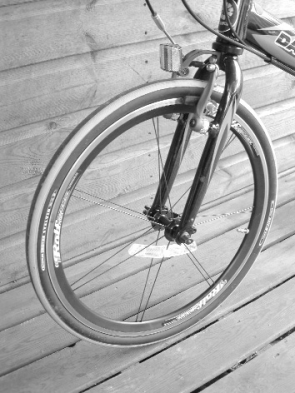
 We judged the conventional Stelvio to have similar rolling resistance to the Brompton or Primo, which was slightly disappointing, but it weighed a few grams less, and was better suited to narrow rims. At 172g, the new ‘Light’ version fitted to the SL is probably the lightest production 406mm tyre in the world. It’s hard to believe that not so long ago, the 260g Primo Comet was considered a world-beater…The Light Stelvio rolls well too, reaching an excellent roll-down speed of 15mph on our test-hill, but in this respect, it’s still narrowly beaten by the Primo. Schwalbe has launched the tyre as a ‘Dahon Special Edition’ in snazzy orange and black, although a mass-market version is expected in the autumn.
We judged the conventional Stelvio to have similar rolling resistance to the Brompton or Primo, which was slightly disappointing, but it weighed a few grams less, and was better suited to narrow rims. At 172g, the new ‘Light’ version fitted to the SL is probably the lightest production 406mm tyre in the world. It’s hard to believe that not so long ago, the 260g Primo Comet was considered a world-beater…The Light Stelvio rolls well too, reaching an excellent roll-down speed of 15mph on our test-hill, but in this respect, it’s still narrowly beaten by the Primo. Schwalbe has launched the tyre as a ‘Dahon Special Edition’ in snazzy orange and black, although a mass-market version is expected in the autumn. As compromises go, the ratios are more or less perfect.The 34-inch bottom gear should get the Helios up most gradients without too much huffing and blowing, and the top gear of 88-inches is tall enough to nip along on the flat with a following breeze, but not high enough for spinning down long gradual descents. Power transmission is wonderfully direct and there’s very little flex from the rear of the bike, so the Helios SL tends to encourage you to work hard and reward you with the desired forward motion. Standing out of the saddle is less satisfactory, because there’s quite a lot of flex in the front of the frame and the handlebar stem, which feels too frail for grunty, sweaty riding. Whether this is enough of a problem to put off the more seriously athletic types remains to be seen. A Bike Friday is certainly tauter, and thus almost certainly a little faster, but within the slightly flexy limitations of the Helios frame, the SL runs a surprisingly close second. And don’t forget how much money you’ve saved.
As compromises go, the ratios are more or less perfect.The 34-inch bottom gear should get the Helios up most gradients without too much huffing and blowing, and the top gear of 88-inches is tall enough to nip along on the flat with a following breeze, but not high enough for spinning down long gradual descents. Power transmission is wonderfully direct and there’s very little flex from the rear of the bike, so the Helios SL tends to encourage you to work hard and reward you with the desired forward motion. Standing out of the saddle is less satisfactory, because there’s quite a lot of flex in the front of the frame and the handlebar stem, which feels too frail for grunty, sweaty riding. Whether this is enough of a problem to put off the more seriously athletic types remains to be seen. A Bike Friday is certainly tauter, and thus almost certainly a little faster, but within the slightly flexy limitations of the Helios frame, the SL runs a surprisingly close second. And don’t forget how much money you’ve saved. Elsewhere it’s hard to see where the weight has been shaved off.The handlebars look like carbon fibre and are called Carbonlite, but seem to be made of aluminium. No matter, they’re clearly very light and they look the part. Speaking of looks, the orange and black tyres, black frame, black stem and orange/yellow saddle may not be your cup of tea, but the general effect is suitably striking. As evidence for this, the hot wheels elicited a nod and grunt from a passing racer – a rare occurrence with a small-wheeler.
Elsewhere it’s hard to see where the weight has been shaved off.The handlebars look like carbon fibre and are called Carbonlite, but seem to be made of aluminium. No matter, they’re clearly very light and they look the part. Speaking of looks, the orange and black tyres, black frame, black stem and orange/yellow saddle may not be your cup of tea, but the general effect is suitably striking. As evidence for this, the hot wheels elicited a nod and grunt from a passing racer – a rare occurrence with a small-wheeler.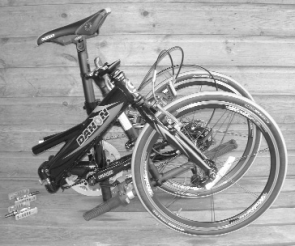

 We’ve never been particularly fond of the 16- inch Di Blasi bicycle. Certainly, it has a clever folding action, but at 14kg it’s on the back-breaking side of heavy, it has too many wobbly joints, and it simply doesn’t stand up in comparison to your typical Brompton or Dahon.We’ll hold fire on the newer 20-inch version, which might perform better.
We’ve never been particularly fond of the 16- inch Di Blasi bicycle. Certainly, it has a clever folding action, but at 14kg it’s on the back-breaking side of heavy, it has too many wobbly joints, and it simply doesn’t stand up in comparison to your typical Brompton or Dahon.We’ll hold fire on the newer 20-inch version, which might perform better. And now, having got enthusiasts for folding and metamorphosing things all steamed up with excitement, we must qualify the more amazing bits.Try lifting the trike, and you’ll discover that it’s a lot heavier than a Brompton – 20.2kg to be precise (Di Blasi, rather unnecessarily, suggest 21kg), whereas a typical folding bike weighs 12kg or so, which most people can manage, at least over short distances.Twenty plus kilograms really is too heavy for the older or frailer folk who might want a trike. A young, able-bodied person might be able to carry it, or lower it into a car boot for you, but on your own, you’ll be stuck.We found a lightweight sack-truck useful for moving the Di Blasi about, but this won’t negotiate steps. Di Blasi do sell a neat bag with a shoulder strap that would make carrying easier and give some disguise on the bus.
And now, having got enthusiasts for folding and metamorphosing things all steamed up with excitement, we must qualify the more amazing bits.Try lifting the trike, and you’ll discover that it’s a lot heavier than a Brompton – 20.2kg to be precise (Di Blasi, rather unnecessarily, suggest 21kg), whereas a typical folding bike weighs 12kg or so, which most people can manage, at least over short distances.Twenty plus kilograms really is too heavy for the older or frailer folk who might want a trike. A young, able-bodied person might be able to carry it, or lower it into a car boot for you, but on your own, you’ll be stuck.We found a lightweight sack-truck useful for moving the Di Blasi about, but this won’t negotiate steps. Di Blasi do sell a neat bag with a shoulder strap that would make carrying easier and give some disguise on the bus. Strangely, few concessions have been made to weight. Besides the cranks and wheels rims, the trike is almost entirely steel (even the rack) and some of the joints and brackets are pretty chunky.We think a weight of 15kg would be feasible with better use of materials, although this would obviously cost more.
Strangely, few concessions have been made to weight. Besides the cranks and wheels rims, the trike is almost entirely steel (even the rack) and some of the joints and brackets are pretty chunky.We think a weight of 15kg would be feasible with better use of materials, although this would obviously cost more.



 Not so long ago, the renowned Joe Breeze – inventor of the mountain bike to some – decided to import a line of folding bikes into the States, as part of his Breezer label’s move away from the MTB.Whose products would this giant of the US bicycle world choose as a partner we wondered? Birdy perhaps? Or maybe Brompton – both were looking to improve their US representation at the time.To our enormous surprise, Joe settled on Oyama, a Taiwanese/Chinese manufacturer of crude, toy-like machines from the murky basement world of budget folders.
Not so long ago, the renowned Joe Breeze – inventor of the mountain bike to some – decided to import a line of folding bikes into the States, as part of his Breezer label’s move away from the MTB.Whose products would this giant of the US bicycle world choose as a partner we wondered? Birdy perhaps? Or maybe Brompton – both were looking to improve their US representation at the time.To our enormous surprise, Joe settled on Oyama, a Taiwanese/Chinese manufacturer of crude, toy-like machines from the murky basement world of budget folders.



 As an internet buyer, the experience was simple. I chose, I clicked, I bought, it arrived the next day, I unpacked, unfolded, fitted the seat, and rode. And nearly fell off. But although your first ten seconds on a Strida are bewildering, your brain quickly reprograms your senses. It’s short, rigid, nippy, and surprisingly comfy. My wife at 5′ 7″ thought it was great, because the riding position really is very upright, and the clever adjustable seat slides up and down the rear of the ‘triangle’ (after loosening three bolts), making it comfortable for both the short and the tall (six foot is probably the maximum though).The handlebars are placed very close to your body, which is unnerving at first, but quickly becomes very natural. It’s sort of steering from your stomach – none of this stretched-out-racer-style lark. I imagined I’d be thrown out of the seat upon mounting pavements and bumping over long grass, but the frame changes (see below) must have worked, because it feels far more rigid than a Brilliant Micro on the road, but is still compliant enough to tackle towpaths.
As an internet buyer, the experience was simple. I chose, I clicked, I bought, it arrived the next day, I unpacked, unfolded, fitted the seat, and rode. And nearly fell off. But although your first ten seconds on a Strida are bewildering, your brain quickly reprograms your senses. It’s short, rigid, nippy, and surprisingly comfy. My wife at 5′ 7″ thought it was great, because the riding position really is very upright, and the clever adjustable seat slides up and down the rear of the ‘triangle’ (after loosening three bolts), making it comfortable for both the short and the tall (six foot is probably the maximum though).The handlebars are placed very close to your body, which is unnerving at first, but quickly becomes very natural. It’s sort of steering from your stomach – none of this stretched-out-racer-style lark. I imagined I’d be thrown out of the seat upon mounting pavements and bumping over long grass, but the frame changes (see below) must have worked, because it feels far more rigid than a Brilliant Micro on the road, but is still compliant enough to tackle towpaths. Strida have made several improvements to the third generation bikes, claiming that the new folding handlebar reduces folded dimensions from 45″ x 21″ x 20″ to 45″ x 21″ x 9″, which reduces folded volume from 309 to 139 litres (10.9 to 4.9 cubic feet)!
Strida have made several improvements to the third generation bikes, claiming that the new folding handlebar reduces folded dimensions from 45″ x 21″ x 20″ to 45″ x 21″ x 9″, which reduces folded volume from 309 to 139 litres (10.9 to 4.9 cubic feet)! To find out if it can cut the commuter mustard, I draped a sheet over my 24-speed Dahon, hung up my pannier bag and resigned to cycling my 11-mile round trip commute on the Strida for a week. I (luckily) don’t have to rely on public transport for any part of my journey, so no news there I’m afraid. First morning out, I allowed an extra 20 minutes, but the ride took only four minutes longer than normal, which surprised me. No drama. No stress, and no obvious flexing from the frame. Every morning for the rest of that week the thought of riding it to work became an exciting challenge.The simplicity of the bike – one gear, drum brakes, and not much else – made me feel like a little kid again.
To find out if it can cut the commuter mustard, I draped a sheet over my 24-speed Dahon, hung up my pannier bag and resigned to cycling my 11-mile round trip commute on the Strida for a week. I (luckily) don’t have to rely on public transport for any part of my journey, so no news there I’m afraid. First morning out, I allowed an extra 20 minutes, but the ride took only four minutes longer than normal, which surprised me. No drama. No stress, and no obvious flexing from the frame. Every morning for the rest of that week the thought of riding it to work became an exciting challenge.The simplicity of the bike – one gear, drum brakes, and not much else – made me feel like a little kid again.
 It isn’t very often we get to test the sexier kind of bicycle. Not that we’re objecting to honest shoppers and folders, or even the less-than-honest Chinese electric MTBs that we seem to make a speciality of condemning these days. But once in a while it’s nice to play with some quality bits and pieces. Something like the Trek F600.
It isn’t very often we get to test the sexier kind of bicycle. Not that we’re objecting to honest shoppers and folders, or even the less-than-honest Chinese electric MTBs that we seem to make a speciality of condemning these days. But once in a while it’s nice to play with some quality bits and pieces. Something like the Trek F600.


 Then there’s the folding technique. Trek folders come with a handbook, but never trust instructions such as ‘…avoid pinching yourself or the cables…’ or ‘…hold the cables out of the way…’. It begins to sound like a three-handed job.
Then there’s the folding technique. Trek folders come with a handbook, but never trust instructions such as ‘…avoid pinching yourself or the cables…’ or ‘…hold the cables out of the way…’. It begins to sound like a three-handed job.

 Briefly, nothing folds smaller (without exception), no other 16-inch folder rides so well (without exception, unless the Russians have produced something we haven’t seen yet), and nothing folds so neatly and so fast.These are the killer attributes that have made the Brompton the commuter bike par excellence and kept the order books full for this small British company, now possibly the largest bicycle manufacturer (as opposed to assembler – ie, bolting on bits) in the UK. One could argue that Pashley still has the Post Office bike contract and the Taiwanese claim to be making things, rather than assembling them, in the Welsh valleys these days, but enough hair-splitting.
Briefly, nothing folds smaller (without exception), no other 16-inch folder rides so well (without exception, unless the Russians have produced something we haven’t seen yet), and nothing folds so neatly and so fast.These are the killer attributes that have made the Brompton the commuter bike par excellence and kept the order books full for this small British company, now possibly the largest bicycle manufacturer (as opposed to assembler – ie, bolting on bits) in the UK. One could argue that Pashley still has the Post Office bike contract and the Taiwanese claim to be making things, rather than assembling them, in the Welsh valleys these days, but enough hair-splitting. We thought we’d need a micrometer to spot the change, but with the bike unfolded, it leaps out at you.Where the curved section of the frame tube used to reach almost to the handlebar stem, the straight bits either side of the hinge give the bike a noticeably different form.
We thought we’d need a micrometer to spot the change, but with the bike unfolded, it leaps out at you.Where the curved section of the frame tube used to reach almost to the handlebar stem, the straight bits either side of the hinge give the bike a noticeably different form. We mentioned this back in October, and although it may not sound the most exciting advance, CAD techniques have enabled the Brompton boffins to reduce the weight of the front pannier bag frame from 690g to 400g.This substantial cut has been achieved through a mixture of light alloy tubes and nylon castings. It’s all very high-tech and Bromptonesque, and makes a noticeable difference to the weight of the pannier bag.With the panniers down in price to £40 – £70 (according to spec, and including the new frame) there’s never been a better time to upgrade that front luggage. If you have a serviceable bag already, the new frame costs about £25.50 on its own.
We mentioned this back in October, and although it may not sound the most exciting advance, CAD techniques have enabled the Brompton boffins to reduce the weight of the front pannier bag frame from 690g to 400g.This substantial cut has been achieved through a mixture of light alloy tubes and nylon castings. It’s all very high-tech and Bromptonesque, and makes a noticeable difference to the weight of the pannier bag.With the panniers down in price to £40 – £70 (according to spec, and including the new frame) there’s never been a better time to upgrade that front luggage. If you have a serviceable bag already, the new frame costs about £25.50 on its own. The dynamo lights on the Brompton have changed out of all recognition in the last few years. Early dynamos whined and seized, while dim bulbs fought to provide illumination.The arrival of a Basta LED rear light and halogen front lamp brought a dramatic improvement a few years ago, and there’s now an Axa HR dynamo too. It’s hard to say how useful this is, but it’s quiet, it rolls easily, and light output, even at low speed, is excellent.
The dynamo lights on the Brompton have changed out of all recognition in the last few years. Early dynamos whined and seized, while dim bulbs fought to provide illumination.The arrival of a Basta LED rear light and halogen front lamp brought a dramatic improvement a few years ago, and there’s now an Axa HR dynamo too. It’s hard to say how useful this is, but it’s quiet, it rolls easily, and light output, even at low speed, is excellent. Another small, but worthwhile development. A tiny plastic rod is fixed into the brake calliper and the previously exposed inner cable is protected from the elements by a flexible rubber gaiter. Brompton brake cables are prone to water ingress because the cables point upwards, so this tiny change should help improve cable life and braking performance on all-weather bikes. Unfortunately, older bikes can only be upgraded by drilling the calliper, but the gaiters cost only £1.50 each.
Another small, but worthwhile development. A tiny plastic rod is fixed into the brake calliper and the previously exposed inner cable is protected from the elements by a flexible rubber gaiter. Brompton brake cables are prone to water ingress because the cables point upwards, so this tiny change should help improve cable life and braking performance on all-weather bikes. Unfortunately, older bikes can only be upgraded by drilling the calliper, but the gaiters cost only £1.50 each. A long long overdue change – the handlebar locking catch has been replaced with a new design that should help to keep the folded handlebars under control, and prevent them flying open at inconvenient moments. A great safety upgrade for older bikes at £3.71, and highly recommended.
A long long overdue change – the handlebar locking catch has been replaced with a new design that should help to keep the folded handlebars under control, and prevent them flying open at inconvenient moments. A great safety upgrade for older bikes at £3.71, and highly recommended. Shaft drives look great on paper, trading that grubby old chain for a completely sealed unit – no gear teeth, no oil, no grime, and no hassle. In reality, they’re relatively inefficient, noisy, heavy and expensive. Altering the gear ratio is a major engineering job, and even measuring the ratio can be complex. Forget what the salesmen say.The chain remains with us today – essentially unchanged for over 100 years – because it’s a damn good solution, unmatched by older and more recent inventions, such as the toothed rubber belt, shaft, oscillating rods, hydraulic, electric and all the rest.
Shaft drives look great on paper, trading that grubby old chain for a completely sealed unit – no gear teeth, no oil, no grime, and no hassle. In reality, they’re relatively inefficient, noisy, heavy and expensive. Altering the gear ratio is a major engineering job, and even measuring the ratio can be complex. Forget what the salesmen say.The chain remains with us today – essentially unchanged for over 100 years – because it’s a damn good solution, unmatched by older and more recent inventions, such as the toothed rubber belt, shaft, oscillating rods, hydraulic, electric and all the rest.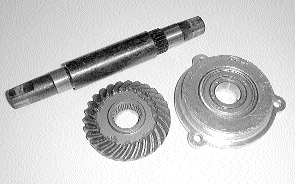
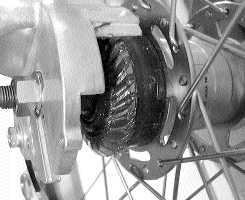
 Sussex markets the steel-framed shaft-drive folder quite widely (you can buy it in the US for $385), but the alloy-framed bike is a more substantial, attractive, and unusually cleanly styled machine.The frame is finished (rather unnecessarily one might think) in lustrous silver metallic paint.The main hinge is a monstrous alloy block in classic Far Eastern style, but it works well enough and incorporates a clever safety device.The pin carrying the quick-release runs in the rear part of the hinge, and when engaged, it drops into a hole in the front part, locking the hinge shut. Even when the quick-release is unfastened, the hinge will not open until the pin is lifted. Simple and effective.The lighter handlebar stem hinge has a similar fitting.
Sussex markets the steel-framed shaft-drive folder quite widely (you can buy it in the US for $385), but the alloy-framed bike is a more substantial, attractive, and unusually cleanly styled machine.The frame is finished (rather unnecessarily one might think) in lustrous silver metallic paint.The main hinge is a monstrous alloy block in classic Far Eastern style, but it works well enough and incorporates a clever safety device.The pin carrying the quick-release runs in the rear part of the hinge, and when engaged, it drops into a hole in the front part, locking the hinge shut. Even when the quick-release is unfastened, the hinge will not open until the pin is lifted. Simple and effective.The lighter handlebar stem hinge has a similar fitting.




 Excitement over, the bus wobbles into what would now be the Swanage bus station and town centre car park, were it not for the efforts of a band of dedicated volunteers, who have restored a working railway.
Excitement over, the bus wobbles into what would now be the Swanage bus station and town centre car park, were it not for the efforts of a band of dedicated volunteers, who have restored a working railway.

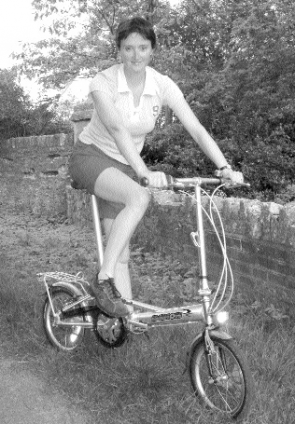
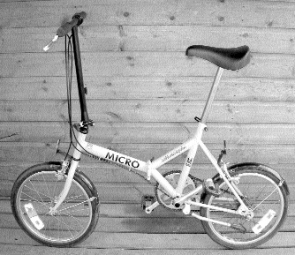
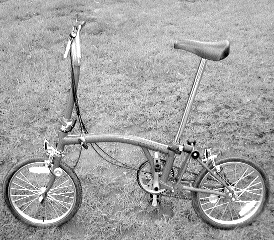
 None of these bikes are great hill-climbers. Despite a bottom ratio of 44 inches, the Brompton does best, because it’s rigid enough for you to stand out of the saddle on steep hills.With a bottom gear of 40 inches and a reasonable frame, the Dahon isn’t far behind, but the little Micro is limited to the sort of gradients that can be climbed with your bottom very firmly on the saddle. Standing out of the saddle on a Micro is an acquired art, and not an especially productive one.Top speed depends on how fast you can twiddle the pedals with a 75-inch top gear (Micro and Presto) and 82-inch gear (Brompton).
None of these bikes are great hill-climbers. Despite a bottom ratio of 44 inches, the Brompton does best, because it’s rigid enough for you to stand out of the saddle on steep hills.With a bottom gear of 40 inches and a reasonable frame, the Dahon isn’t far behind, but the little Micro is limited to the sort of gradients that can be climbed with your bottom very firmly on the saddle. Standing out of the saddle on a Micro is an acquired art, and not an especially productive one.Top speed depends on how fast you can twiddle the pedals with a 75-inch top gear (Micro and Presto) and 82-inch gear (Brompton).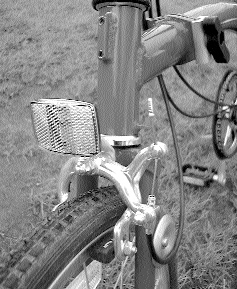
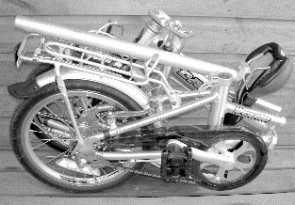
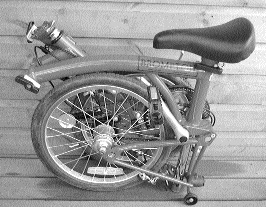
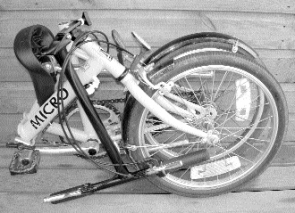

 Whenever we test a new Dahon these days, we seem to remark on how well the machines are coming on. In motoring terms, Dahon is the Ford of the folding bike world – lots of models and mega- bucks global sales. These are machines for everyman – not upper class super- compacts like the Brompton, or testosterone-fuelled jobbies like the Bike Friday, but good honest value for money machines. And the value side of things just keeps getting better.Thanks to Dahon’s new Chinese factory, and a price realignment with Europe, UK prices have tumbled in the last year.They’re now virtually on a par with the United States, which is almost unknown for a folding bike, or indeed, any sort of bike.
Whenever we test a new Dahon these days, we seem to remark on how well the machines are coming on. In motoring terms, Dahon is the Ford of the folding bike world – lots of models and mega- bucks global sales. These are machines for everyman – not upper class super- compacts like the Brompton, or testosterone-fuelled jobbies like the Bike Friday, but good honest value for money machines. And the value side of things just keeps getting better.Thanks to Dahon’s new Chinese factory, and a price realignment with Europe, UK prices have tumbled in the last year.They’re now virtually on a par with the United States, which is almost unknown for a folding bike, or indeed, any sort of bike.


 To begin with, it’s standard Dahon stuff – the handlebars fold down to the left, then the main frame breaks in the middle and folds to the left, sandwiching the bars. But there’s an extra fiddly element on the Vitesse, because the handlebars need to be rotated in the stem to prevent the brake levers fouling the stand and/or the ground. As delivered, the bars needed little rotation, but this set-up felt all wrong on the road, putting the levers too high and the gear indicator too low.With the brakes and gear-shift moved to a more comfortable position, the bars had to be rotated by nearly 180 degrees when folding the bike. It’s all a bit fiddly – fine for the occasional Sunday outing to the park, but much too annoying for a regular train commute.
To begin with, it’s standard Dahon stuff – the handlebars fold down to the left, then the main frame breaks in the middle and folds to the left, sandwiching the bars. But there’s an extra fiddly element on the Vitesse, because the handlebars need to be rotated in the stem to prevent the brake levers fouling the stand and/or the ground. As delivered, the bars needed little rotation, but this set-up felt all wrong on the road, putting the levers too high and the gear indicator too low.With the brakes and gear-shift moved to a more comfortable position, the bars had to be rotated by nearly 180 degrees when folding the bike. It’s all a bit fiddly – fine for the occasional Sunday outing to the park, but much too annoying for a regular train commute.
 This lecture was originally presented by author Tony Hadland at the CYCLE 2002 show in London, September 2002.The emphasis is on British- designed and foreign folding bikes that had a significant impact in the UK. ‘Portable’ is used inclusively to represent folding, separable and demountable cycles.
This lecture was originally presented by author Tony Hadland at the CYCLE 2002 show in London, September 2002.The emphasis is on British- designed and foreign folding bikes that had a significant impact in the UK. ‘Portable’ is used inclusively to represent folding, separable and demountable cycles.



